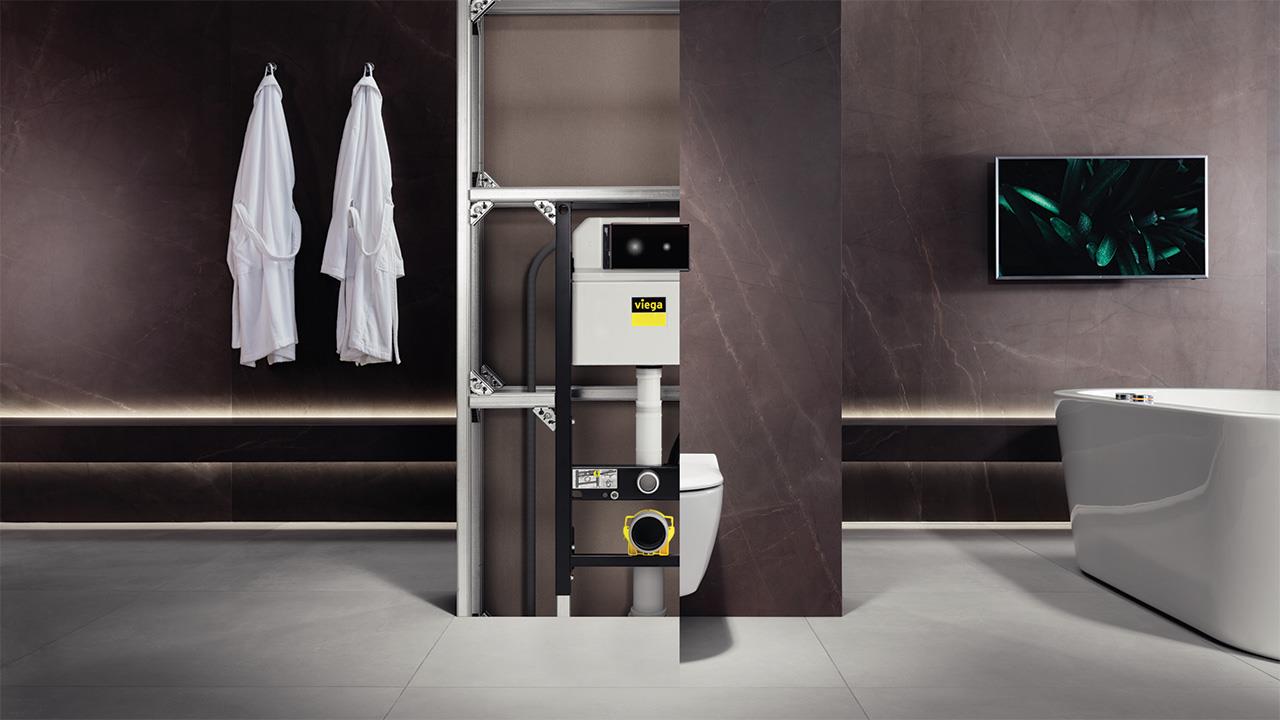

Scott James, Managing Director at Viega, looks at the key features that need to be considered when selecting a pre-wall system to ensure a successful installation and long-lasting solution.
In recent years, bathrooms have steadily become one of the most marketable and important parts of the experience for the residential and hospitality sectors. The ongoing popularity of minimalist bathroom designs has led to an increase in the use of concealed toilet cisterns, which are used to not only optimise space, but also to create an open, uncluttered aesthetic.
Pre-wall frames offer several key benefits including increased hygiene, flexibility in design and, most importantly, easy installation. This type of system delivers supreme comfort with individually adjustable toilets and washbasin elements that are ideal for multigenerational households, and digital flush actuation that can help maintain water hygiene. However, it is important to understand the options available to ensure the most suitable product is chosen.
One key factor that needs to be considered when selecting a pre-wall frame system is the physical dimensions of the unit, especially if there is not a lot of space in the bathroom. Typically, the frames and mechanisms will require a void of just 200mm or less, and often it is the diameter of the waste pipe that sets the minimum void space. If the solid wall behind the cistern can be modified to fit the pipe, installers can then reduce the minimum space further.
It is also worth considering the height of the system. Frames come in a variety of heights, including 820mm and 980mm, which enables convenient installation of a WC at low height, such as below sloping roofs, windows, or shelves.
Another consideration is the loading capacity of the frame. Installers should look to use frames that have been rigorously tested for intentional or accidental misuse, and to ensure that the frames are able to withstand forces greater than typical day to day use. For example, Viega’s WC and bidet frames can support up to 400kg of weight, roughly five or six times the weight of the average UK adult, while the washbasin and urinal frames are tested to 150kg, in case of misuse.
One element that is often overlooked is the transmission of sounds from the bathroom to the bedroom or living space. Document E of the Building Regulations provides guidance on reducing unwanted sound through and between buildings. The regulations require that any internal walls between a bedroom and bathroom provide ‘resistance to the passage of sound,’ therefore the correct choice of pre-wall systems is vital to ensure a quiet environment.
It is also worth considering systems with cisterns that have been designed to achieve a quieter flush to minimise airborne sound. These cisterns will be enclosed in a housing unit to ensure a quieter flushing sound. In addition, installers should also look for pre-wall systems that have been trialled and tested for sound performance.
Lastly, it is important to consider the different people who will be using the bathroom including children, the elderly, and those with disabilities. The rise in multigenerational households means that it is an increasingly common requirement to have flexible options. For example, some pre-wall frame units available allow the height of WCs and washbasins to be adjusted at the push of a button to provide simple adaption to the needs of different users.
The bathroom has become a significant living space for many people of different generations. It provides relaxation, wellness, and hygiene, so when specifying pre-wall systems, it is worth considering flush plate controls, which are an essential element of wall hung and concealed systems. Flush plates typically have a lower activation pressure compared with some alternatives and, due to the larger surface area, applying the required force is easier.
There are also touchless products available that sense when the user’s hand is close to the panel and trigger the flush mechanism, making it an ideal option for users with reduced strength. Furthermore, this provides enhanced hygiene, as the lack of buttons or moving parts on the front of the plate means it is easy to clean.
As pre-wall units continue to evolve and change the bathroom landscape, it is important for tradespeople to select the appropriate solution for their customers. In doing so, not only can they offer a space-saving and minimalistic aesthetic, but also a reliable and long-lasting solution for many households.
If you'd like to keep up-to-date with the latest developments in the heating and plumbing industry, why not subscribe to our weekly newsletters? Just click the button below and you can ensure all the latest industry news and new product information lands in your inbox every week.